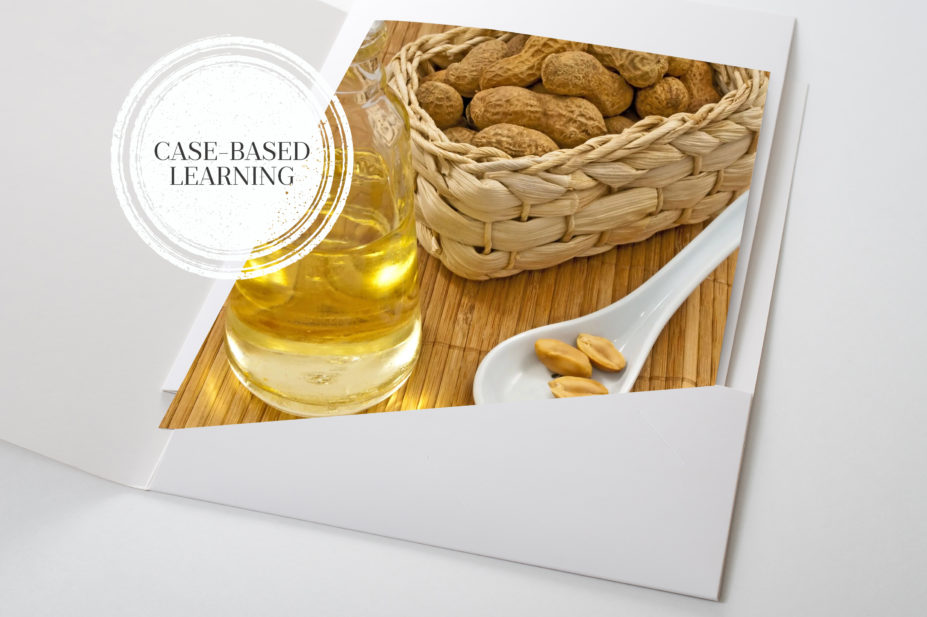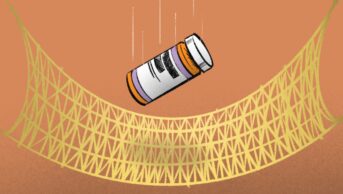
Shutterstock.com
When a patient is admitted to hospital, one of the first things that is sought as part of their history is their allergy status. This vital information is used to ensure patients do not receive a therapy that could cause them harm. A common example recorded on a patient’s notes is penicillin allergy. Having access to this information, the prescriber can find out more about the reaction (i.e. does it cause anaphylaxis, or just a rash? [see Anaphylaxis: symptoms, causes and diagnosis]) or simply not prescribe penicillin-based antibiotics. However, in this example, the allergy is to the named product, but many medicines contain ingredients that cause allergy and may not be apparent. The following article highlights one such case, outlining the circumstances that nearly led to patient harm.
The incident
An incident occurred at Sheffield Children’s NHS Foundation Trust when a prescription for chlorhexidine dihydrochloride and neomycin sulfate nasal cream (i.e. Naseptin [Alliance Pharmaceuticals]) was presented to be dispensed for a child with a peanut allergy.
In accordance with the Trust’s standard operating procedures and the National Institute for Health and Care Excellence (NICE) guideline on drug allergy diagnosis and management, the parent presenting the prescription was asked if the child had any allergies[1]
. The parent informed the receptionist that the child had a peanut allergy and the prescription was annotated with this information. It is standard practice at Sheffield Children’s NHS Foundation Trust to record on the prescription if a child has a food or drug allergy.
The annotated prescription was given to the pharmacist for clinical checking. The pharmacist knew the dose of chlorhexidine dihydrochloride and neomycin sulfate nasal cream and did not consult the British National Formulary for Children on this occasion. Had they done so, they would have seen that the product contains arachis (peanut) oil[2]
.
The prescription was then passed to a dispenser, who labelled the product. The pharmacy’s computer system offered the additional label “Contains arachis oil”; however, this was not included on the label as the dispenser did not understand its significance. The product packaging for the chlorhexidine dihydrochloride and neomycin sulfate nasal cream stated: “Contains peanut oil”; however, the dispenser did not notice this warning.
The product was given to a pharmacy technician for accuracy checking, who was unaware that the product contains arachis oil and did not notice the warning on the packaging. They then dispensed the product to the parent.
Later that day, the parent noticed the warning on the box and read the patient information leaflet, which advised against using the product in patients with a peanut allergy. Consequently, the parent phoned the pharmacy for advice. It was only at this stage that the pharmacy team realised the error. The team contacted the child’s doctor, who prescribed an alternative ointment that did not contain arachis oil.
What went wrong
In the UK, primary nut allergy (an allergy characterised by specific immunoglobulins against surface proteins present in certain nuts) affects more than 2% of children and 0.5% of adults; in the most serious cases, a person can have a severe allergic reaction (anaphylaxis), which can be life threatening[3],[4]
.
Thankfully, this was not the outcome in this case, but using the accident causation model, devised by James Reason in 1990, it is possible to identify which parts of the system failed and what changes can be made to improve safety in clinical practice[5],[6]
. Using this model, the errors can be categorised into ‘mistakes’ (i.e. an incorrect plan was formulated and followed) and ‘lapses’ (i.e. when a step of the plan was omitted or forgotten)[5]
.
In this incident, the primary error was the prescribing of a contraindicated medicine to a patient with a peanut allergy by the doctor, who did not realise that the product contained arachis oil. Reason’s model would classify this lack of knowledge as a mistake. This same lack of knowledge by the pharmacist and pharmacy technician compounded the problem[6]
. The dispenser was not expected to know the composition of the product, so their knowledge gap was slightly different.
Refined arachis oil is an excipient in various pharmaceutical products; it is often added to preparations as a ‘carrier’ for other drugs (e.g. Sustanon injection [Aspen]) or to aid absorption of some emollients (e.g. Zinc and castor oil ointment BP [Thornton & Ross])[7]
. The oil is refined to remove the proteins that trigger an allergic response, which makes it unlikely to cause a reaction in people with peanut allergy. However, the European Pharmacopoeia does not require testing for residual protein in arachis oil, so trace amounts of peanut protein may remain in these products[8],[9]
. Furthermore, it is important to note that peanuts are legumes, rather than nuts; therefore, patients who are allergic to peanuts may be sensitised to other legumes, such as soya beans[3]
. As a result, the European Medicines Agency advises that the summary of product characteristics and the package leaflet of medicines which contain arachis oil must state that the product is contraindicated in patients with a known peanut or soya allergy[10]
.
Using Reason’s model, the secondary errors of the pharmacy technician and dispenser omitting a step in the plan (i.e. not reading the warning on the packaging, or not investigating what arachis is when the opportunity presented itself) are considered lapses[6]
.
Response to the incident
Once the error was identified, the department’s error standard operating procedure was instigated and the incident investigated. This requires the staff involved in the incident to reflect on what went wrong, so that they can determine the system failings and remedy them. In this case, the reflections revealed:
- A lack of knowledge about the presence of arachis oil in medicines;
- A lack of knowledge about the term arachis oil;
- A lapse in reading the information on the packaging.
To address the mistake, a poster of the trust’s formulary medicines that contain arachis oil was created (see Figure 1). The poster was circulated in the trust’s medicines management newsletter, and was prominently displayed on ward stock cupboards, so that medical and nursing staff would be aware of the potential for allergy with these products.

Figure 1: Sheffield Children’s NHS Foundation Trust ‘Think Nuts’ poster
To address the lapses, the warning label was updated on the pharmacy system to make it clearer: “Warning: contains arachis oil. Do not use if you have a peanut allergy”. This means that everyone who is involved in the dispensing process can see and understand the information. The label also acts as a prompt to check the allergy status of the patient, as well as for people taking or administering medicines to provide an additional safety net, should the same type of incident occur again.
In addition, training sessions took place in the pharmacy to bridge the knowledge gaps that had been identified.
Review of the incident
Fortunately, this incident did not result in harm for the patient; the child’s parents intervened before any medicine was taken. Reflection and learning uncovered knowledge gaps within the trust, and the staff received and applied learning that will prevent such incidents occurring in the future. This is supported by the implementation of more robust processes (i.e. the information poster and the reworded label) to ensure that information is available to staff involved in dispensing and administration.
From a small study into the potential allergenicity of refined arachis oil, it appears that there was a low risk that the child would react to it in their nasal ointment[11]
. However, there are other agents available for this indication (nasal infection) that do not contain arachis oil; therefore, it seemed prudent to recommend an alternative product. In a situation where the illness was life threatening, and there was no alternative product, prescribers may choose to use a product containing refined arachis oil off-label.
Patient consent
Parental/guardian consent was obtained prior to publication of this case study.
References
[1] National Institute for Care and Health Excellence. Drug allergy: diagnosis and management. Clinical guideline [CG183]. 2014. Available at: www.nice.org.uk/guidance/cg183 (accessed January 2021)
[2] British National Formulary for Children. Chlorhexidine with neomycin. 2020. Available at: https://bnfc.nice.org.uk/medicinal-forms/chlorhexidine-with-neomycin.html (accessed January 2021)
[3] Stiefel G, Anagnostou K, Boyle RJ et al. BSACI guideline for the diagnosis and management of peanut and tree nut allergy. Clinical & Experimental Allergy 2017;47(6):719–739. doi: 10.1111/cea.12957
[4] NHS. Overview — food allergy. 2019. Available at: https://www.nhs.uk/conditions/food-allergy (accessed January 2021)
[5] Garfield S & Dean Franklin B. Understanding models of error and how they apply in clinical practice. Pharm J 2016;296(7890):361–364. doi: 10.1211/PJ.2016.20201110
[6] Reason J. Human Error. Cambridge: Cambridge University Press; 1990
[7] Aulton ME & Taylor KMG. Aulton’s Pharmaceutics: The design and manufacture of medicines. Edinburgh: Elsevier; 2017
[8] European Medicines Agency. Annex to the European Commission guideline on ‘Excipients in the labelling and package leaflet of medicinal products for human use’ (SANTE-2017-11668). 2019. Available at: https://www.ema.europa.eu/en/documents/scientific-guideline/annex-european-commission-guideline-excipients-labelling-package-leaflet-medicinal-products-human_en.pdf (accessed January 2021)
[9] Paediatric Formulary Committee. BNF for Children. London: BMJ Group, Pharmaceutical Press and RCPCH Publications; 2019
[10] Specialist Pharmacy Service. Arachis oil in medicines — what are the risks of developing peanut allergy? 2016. Available from: https://www.sps.nhs.uk/articles/arachis-oil-in-medicinesnwhat-are-the-risks-of-developing-peanut-allergy/ (accessed January 2021)
[11] Hourihane JO’B, Bedwani SJ, Dean TP & Warner JO. Randomised, double blind, crossover challenge study of allergenicity of peanut oils in subjects allergic to peanuts. BMJ 1997;314:1084. doi: 10.1136/bmj.314.7087.1084


